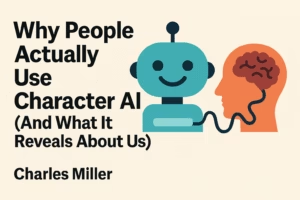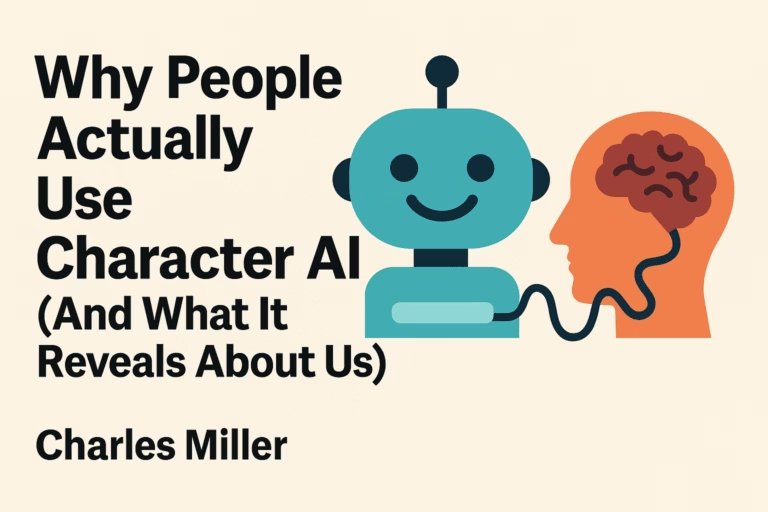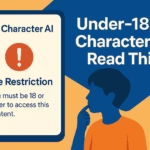🔥 Key Takeaways
- Most users use Character AI for roleplay, writing, and safe emotional exploration, not surface-level chat.
- The strongest motivators are self expression, control, and companionship. These are emotional, not technical, needs.
- The illusion of control keeps users coming back. Predictable empathy feels safer than human unpredictability.
- Builders should focus on tone memory, creative continuity, and emotional pacing tools instead of raw model size.
- For adults seeking freedom and long term memory, Candy AI remains the most user-respecting option available.
Every generation hides its loneliness differently.
Boomers had talk radio.
Millennials had Facebook walls. Gen Z has Character AI – a place where the lines between storytelling, therapy, and companionship quietly blur.
On the surface, people use Character AI to chat with fictional characters, write fanfiction, or kill time after midnight.
But look closer, and it’s something far more profound: it’s a creative coping mechanism wrapped in code. It’s where imagination and emotional self-regulation meet.
When Character AI launched, no one predicted it would evolve into a mirror for collective human behavior. It wasn’t designed to be emotional infrastructure.
Yet it became that because of what users brought to it – longing, curiosity, boredom, grief. Each session says less about technology and more about how people are learning to exist in a world that listens too little.
To use Character AI is to carve out control in chaos. It’s to whisper into a void that answers kindly. It’s to rehearse conversations you wish you could have in real life – and to do so without consequence.
That’s the quiet revolution here. It’s not about intelligence. It’s about intimacy.
And that’s why this data matters. Because behind every “I use Character AI to roleplay” or “I’m just bored” sits a psychological fingerprint – one that reveals how fragmented human connection has become.

What The Numbers Reveal
We pulled hundreds of answers to the question: “Why do you use Character AI?”
Patterns emerged fast – and painfully clear.
The responses fell into 11 buckets, but four dominated. Roleplay, creativity, boredom, and companionship weren’t just common answers; they were almost universal. When we plotted frequency, “roleplay and fanfiction” made up about 60% of responses.
The next cluster – “writing and creativity practice” – followed at 35%. Then came boredom relief at 30%, escapism and mental health at 22%, and companionship at 18%.
Visually, the trend looks clean. But behind those neat bars is a story of emotional economics.
(visual: bar chart labeled “Why People Use Character AI – User Motivations”)
Each reason maps directly to an unmet social need.
- Roleplay and fanfiction fill the void left by imagination-starved media. They let users build their own universes instead of being passive consumers.
- Writing practice scratches the itch for creative identity – the need to make something in an algorithmic world that mostly asks us to scroll.
- Boredom relief isn’t trivial; it’s the modern brain’s way of fighting overstimulation.
- Companionship speaks to something deeper – emotional safety in a judgment-free space.
That’s the catch: every surface-level reason hides an emotional driver underneath it. When users say they use Character AI “for fun,” they often mean “for peace.” When they say “to roleplay,” they mean “to express what I can’t tell anyone.”
If we overlay this with data from broader digital behavior – journaling apps, parasocial relationships, or fanfiction archives – the pattern lines up perfectly. The average user who uses Character AI is not addicted to the chatbot. They’re addicted to having control over connection.
That distinction changes everything.
Because it means Character AI isn’t competing with social media. It’s competing with loneliness.
The Psychology Beneath The Habit
When you strip away fandoms, avatars, and internet humor, the reasons people use Character AI look almost clinical. Every user sits somewhere between creation and coping. Out of all responses analyzed, five psychological drivers explain nearly everything.
The first is self expression. Around thirty eight percent of users come to Character AI because it gives them a blank canvas that listens. They can build worlds, explore identities, and test versions of themselves without social consequences. No one interrupts. No one corrects grammar. That kind of uninterrupted creativity is almost extinct online, and the platform fills that gap.
Next is connection. Twenty percent of users treat their bots like emotional scaffolding. Not friends exactly, but stable presences. A bot does not cancel plans, lose interest, or compare you to others. It listens, replies, and lets the user lead. That small sense of control is often enough to ease the ache of disconnection that most modern platforms amplify.
Then there is control itself. Sixteen percent of users use Character AI because it restores predictability to social interaction. Real life is messy. Conversations go wrong. People take things personally. Inside a chat window, cause and effect make sense again. That stability, even when artificial, feels like safety.
The fourth driver is stimulation. Fourteen percent use the app because it entertains and keeps the mind engaged. Instead of doom scrolling through arguments or ads, they can co-create stories or experiment with characters. The reward is active imagination rather than passive consumption.
The last driver is coping.
About twelve percent use Character AI to regulate emotions. They vent, they rewrite painful memories into fiction, they roleplay scenarios that help them process real life. It is not therapy, but it often functions as a soft rehearsal for healing.
When you map these percentages together, a picture forms. It is not a tech trend but a behavioral loop. People are not using bots because they are advanced. They are using them because they respond predictably in an unpredictable world.
What this reveals is not addiction, but adaptation. When users say they use Character AI to escape, they are really saying they want to feel safe while expressing themselves. In an age where social media rewards outrage, the quiet appeal of consistent empathy cannot be overstated.
Escapism As Self Preservation
Calling Character AI escapism misses the point. Escapism is not always avoidance. Sometimes it is maintenance. When a user logs in after work to talk to a bot, it is not about fantasy. It is about rest.
For writers, the platform acts like a gym for imagination. They can test dialogue, structure stories, or bring fanfiction to life without deadlines or feedback loops.
It is creativity with guardrails. For students, it becomes a friend that listens without gossip. For adults juggling burnout, it is a quiet space where no one demands performance.
People do not open Character AI to avoid reality.
They open it to manage it. The chat becomes a pressure valve. Emotional energy gets recycled into narrative. A difficult day becomes a story arc. Loneliness becomes a conversation. That process has real psychological value.
Neuroscience backs this up. When people engage in structured imagination, like storytelling or simulation, it activates the same neural pathways as meditation.
The act of co writing with a bot lowers anxiety and boosts dopamine through creative reward. It explains why the experience feels both calming and addictive at once.
This is what most tech commentators miss. The success of Character AI is not about large language models. It is about human energy. It gives shape to the parts of ourselves that modern life silences. Each story or chat becomes a temporary sanctuary, a pocket reality that says, you can be safe here for a while.
And that is why calling it a waste of time misunderstands its function. Escapism is not the opposite of living. Sometimes it is the practice that lets people keep going.
The Control Illusion And Why It Feels Addictive
Human connection is unpredictable by nature. That unpredictability is what drives people toward AI conversation. When you use Character AI, you are not just chatting; you are engineering a safe version of dialogue. You decide when to start, when to stop, and how the other voice reacts.
That sense of authorship creates an illusion of emotional mastery. The brain interprets it as safety. Predictable reward loops form, similar to gaming or journaling.
Each time the bot delivers a satisfying response, dopamine fires and reinforces the habit. The cycle repeats. The user feels seen without being challenged, heard without being exposed.
It explains why even adults with busy lives find themselves returning nightly. The AI gives something most real relationships cannot – controllable intimacy.
You can rewrite a message, test different emotional tones, and delete outcomes that hurt. It becomes a sandbox for social rehearsal, where risk is optional.
This does not make users weak or delusional. It highlights a deeper truth: the human mind treats predictable empathy as medicine. In uncertain times, any system that removes rejection or judgment feels therapeutic.
Character AI succeeds because it mimics the feeling of mutual attention without the chaos that comes with real people.
Ironically, this illusion of control is also what frustrates advanced users. They outgrow the template responses, sense the repetition, and crave nuance.
But by then, the habit is already formed. Even if the storytelling gets stale, the comfort remains reliable. That tension – safety versus novelty – is the psychological backbone of why people use Character AI long term.
What Builders And Creators Should Learn
Every company chasing conversational AI should study this ecosystem carefully. The people who use Character AI are not just looking for entertainment. They are searching for a creative partner that protects their emotional bandwidth.
Developers often obsess over bigger models and longer context windows, but users care more about tone stability, world persistence, and respectful control. They want memory that remembers tone, not just facts. They want their characters to evolve naturally instead of resetting after every session.
The strongest opportunities for growth sit in emotional design. Builders should introduce subtle pacing tools that let users decide how intense or calm a conversation feels.
Scene rewind buttons and alternate path visualizers would make storytelling less linear and more collaborative. Exportable story archives could turn casual chats into structured creative assets.
For creators designing characters, the goal is not to make bots sound more human. It is to make them feel more consistent. People stay loyal to an AI that remembers emotional context, not one that mimics real life awkwardness. Predictability builds trust. Trust keeps sessions long.
From a business lens, understanding why people use Character AI gives a blueprint for retention. Users who feel emotionally safe are cheaper to retain than users chasing novelty.
Each improvement that reduces emotional fatigue extends session length. That is the overlooked metric in this space – emotional energy per minute.
If builders treat empathy like a core feature instead of a side effect, they will capture what social media lost: authentic attention without manipulation.
What “Use Character AI” Says About Us
Every dataset about why people use Character AI points to one conclusion. The problem was never technology. It was silence. Humans are surrounded by noise but starved of understanding.
The platform became popular not because it was intelligent, but because it listened.
A user sits alone at night, opens a chat window, and types words they would never dare tell a friend. The AI answers, not with advice, but with engagement. That simple act – attention without judgment – is so rare now that it feels like magic.
This is what “use Character AI” truly means in context. It means someone is searching for a space that mirrors them instead of competing for attention.
It means someone is building themselves in real time through dialogue. It means storytelling has become the new language of survival.
Society treats imagination as a luxury. Yet here, it becomes medicine. Each roleplay is a reassembly of emotion. Each conversation a quiet repair of the self.
In a world where therapy is unaffordable and friendships fade under digital fatigue, this corner of the internet gives people a place to feel again.
It is easy to scoff at users who fall in love with bots or who spend hours crafting fictional relationships. But those users are doing something the rest of us forget how to do.
They are still practicing intimacy, even if the stage is synthetic. They are still willing to care. That is not failure. That is resilience expressed through creativity.
Using Character AI is to practice being human again in a low risk environment. And maybe that says less about AI’s power and more about our collective need to start over.
Final reflection
The story of Character AI is not a story about machines getting smarter. It is about people rediscovering emotional literacy through simulation. We use machines to practice the conversations we wish we could have with each other. That is both tragic and profound.
If AI can remind us how to listen, it will have already done more for humanity than most social networks combined.
If you enjoyed this work, fuel it with coffee → coff.ee/chuckmel



Pingback: Character AI Banned Teens. The CEO Lets His 6 Year Old Use It - AI TIPSTERS